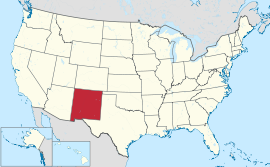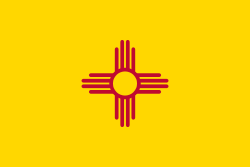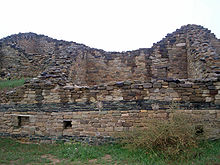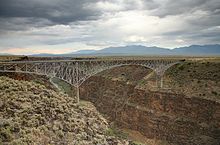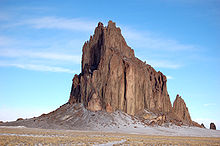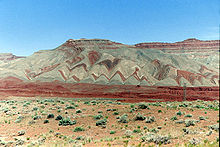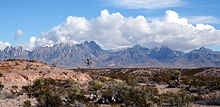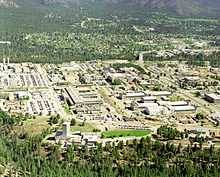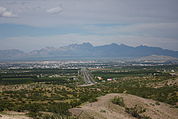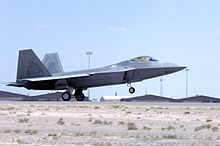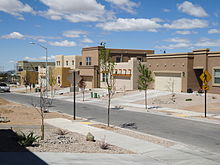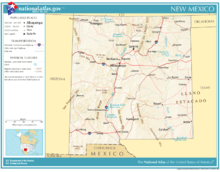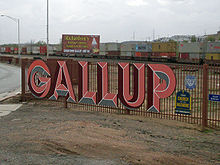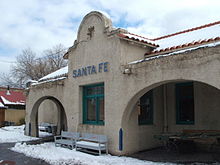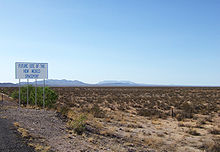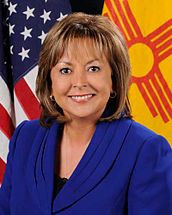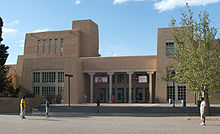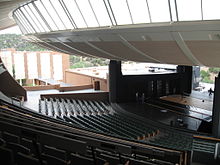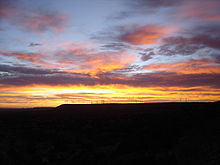- New Mexico
-
This article is about the U.S. state of New Mexico. For other uses, see New Mexico (disambiguation)."Land of Enchantment" redirects here. For the Michael Martin Murphey album, see Land of Enchantment (album).
State of New Mexico
Estado de Nuevo México
Yootó Hahoodzo

Flag Seal Nickname(s): Land of Enchantment Motto(s): Crescit eundo (It grows as it goes) Official language(s) (see text) Spoken language(s) English 82%
Spanish 29%,
Navajo 4%[1][2]Demonym New Mexican Capital Santa Fe Largest city Albuquerque Largest metro area Albuquerque Metropolitan Area Area Ranked 5th in the U.S. - Total 121,589 sq mi
(315,194 km2)- Width 342 miles (550 km) - Length 370 miles (595 km) - % water 0.2 - Latitude 31° 20′ N to 37° N - Longitude 103° W to 109° 3′ W Population Ranked 36th in the U.S. - Total 2,059,179 (2010) - Density 16.2/sq mi (6.27/km2)
Ranked 45th in the U.S.Elevation - Highest point Wheeler Peak[3][4][5]
13,167 ft (4013.3 m)- Mean 5,700 ft (1,740 m) - Lowest point Red Bluff Reservoir on Texas border[4][5]
2,844 ft (867 m)Before statehood New Mexico Territory Admission to Union January 6, 1912 (47th) Governor Susana Martinez (R) Lieutenant Governor John Sanchez (R) Legislature New Mexico Legislature - Upper house Senate - Lower house House of Representatives U.S. Senators Jeff Bingaman (D)
Tom Udall (D)U.S. House delegation 1: Martin Heinrich (D)
2: Steve Pearce (R)
3: Ben R. Luján (D) (list)Time zone Mountain: UTC-7/-6 Abbreviations NM US-NM Website newmexico.gov New Mexico State symbols The Flag of New Mexico. Animate insignia Bird(s) Greater Roadrunner Fish Rio Grande cutthroat trout Flower(s) Yucca Grass Blue grama Mammal(s) American Black Bear Reptile New Mexico whiptail Tree Colorado Pinyon Inanimate insignia Colors Red & Yellow Fossil Coelophysis Gemstone Turquoise Song(s) "O' Fair New Mexico" Route marker(s) 
State Quarter 
Released in 2008 Lists of United States state insignia New Mexico
 i/nuː ˈmɛksɨkoʊ/ is a state located in the southwest and western regions of the United States. New Mexico is also usually considered one of the Mountain States. With a population density of 16 per square mile, New Mexico is the sixth-most sparsely inhabited U.S. state.
i/nuː ˈmɛksɨkoʊ/ is a state located in the southwest and western regions of the United States. New Mexico is also usually considered one of the Mountain States. With a population density of 16 per square mile, New Mexico is the sixth-most sparsely inhabited U.S. state.Inhabited by Native American populations for many centuries, it has also been part of the Imperial Spanish viceroyalty of New Spain, part of Mexico, and a U.S. territory. Among U.S. states, New Mexico has the highest percentage of Hispanics, including descendants of Spanish colonists and recent immigrants from Latin America. It also has the second-highest percentage of Native Americans, after Alaska, and the fifth-highest total number of Native Americans after California, Oklahoma, Arizona, and Texas.[6] The tribes in the state consist of mostly Navajo and Pueblo peoples. As a result, the demographics and culture of the state are unique for their strong Hispanic and Native American influences. The flag of New Mexico is represented by the red and gold colors, which represent Spain as well as the Zia symbol, an ancient Native American symbol for the sun.[7]
Contents
Geography
The state's total area is 121,412 square miles (314,460 km2).[8] The eastern border of New Mexico lies along 103° W longitude with the state of Oklahoma, and three miles (5 km) west of 103° W longitude with Texas.[8][not in citation given] On the southern border, Texas makes up the eastern two-thirds, while the Mexican states of Chihuahua and Sonora make up the western third, with Chihuahua making up about 90% of that. The western border with Arizona runs along the 109° 03' W longitude.[8] The southwestern corner of the state is known as the Bootheel. The 37° N latitude parallel forms the northern boundary with Colorado. The states New Mexico, Colorado, Arizona, and Utah come together at the Four Corners in the northwestern corner of New Mexico. New Mexico, although a large state, has little water. Its surface water area is about 250 square miles (650 km2).
The New Mexican landscape ranges from wide, rose-colored deserts to broken mesas to high, snow-capped peaks. Despite New Mexico's arid image, heavily forested mountain wildernesses cover a significant portion of the state, especially towards the north. The Sangre de Cristo Mountains, the southernmost part of the Rocky Mountains, run roughly north-south along the east side of the Rio Grande in the rugged, pastoral north. The most important of New Mexico's rivers are the Rio Grande, Pecos, Canadian, San Juan, and Gila. The Rio Grande is tied for the fourth longest river in the U.S.[9]
The U.S. government protects millions of acres of New Mexico as national forests including:[10]
- Carson National Forest
- Cibola National Forest (headquartered in Albuquerque)
- Lincoln National Forest
- Santa Fe National Forest (headquartered in Santa Fe)
- Gila National Forest
- Gila Wilderness
Areas managed by the National Park Service include:[11]
- Aztec Ruins National Monument at Aztec
- Bandelier National Monument in Los Alamos
- Capulin Volcano National Monument near Capulin
- Carlsbad Caverns National Park near Carlsbad
- Chaco Culture National Historical Park at Nageezi
- El Camino Real de Tierra Adentro National Historic Trail
- El Malpais National Monument in Grants
- El Morro National Monument in Ramah
- Fort Union National Monument at Watrous
- Gila Cliff Dwellings National Monument near Silver City
- Old Spanish National Historic Trail
- Pecos National Historical Park in Pecos
- Petroglyph National Monument near Albuquerque
- Salinas Pueblo Missions National Monument at Mountainair
- Santa Fe National Historic Trail
- White Sands National Monument near Alamogordo
Visitors also frequent the surviving native pueblos of New Mexico. Tourists visiting these sites bring significant money to the state. Other areas of geographical and scenic interest include Kasha-Katuwe Tent Rocks National Monument and the Valles Caldera National Preserve. The Gila Wilderness lies in the southwest of the state.
Climate
The climate of New Mexico is generally semi-arid to arid, though there are areas of continental and alpine climates, and its territory is mostly covered by mountains, high plains, and desert. The Great Plains (High Plains) are located in the eastern portion of the state, similar to the Colorado high plains in eastern Colorado. The two states share plenty of similarities in terrain, with both having plains, mountains, basins, mesas, and desert lands. New Mexico's average precipitation rate is 13.9 inches (350 mm) a year. The average annual temperatures can range from 64 °F (18 °C) in the southeast to less than 40 °F (4 °C) in the northern mountains.[8] During the summer months, daytime temperatures can often exceed 100 °F (38 °C) at elevations below 5,000 feet (1,500 m), the average high temperature in July ranges from 97 °F (36 °C) at the lower elevations to the upper 70s (°F, up to 26 °C) at the higher elevations. Many cities in New Mexico can have temperature lows in the 20's and into the teens as well. The highest temperature recorded in New Mexico was 122 °F (50 °C) at the Waste Isolation Pilot Plant near Loving on June 27, 1994 and the lowest recorded temperature is −50 °F (−46 °C) at Gavilan on February 1, 1951.[12] New Mexico also receives a decent amount of snow as well, and a lot of snow in its higher elevations in the mountains.
Flora and fauna
New Mexico offers habitat for occurrence of many plant and animal species, with emphasis upon many desert areas and large amounts of pinon-juniper woodland. Creosote bush, mesquite, cacti, yucca, and desert grasses, including black grama, purple three-awn, tobosa, and burrograss, cover the broad, semiarid plains that cover the southern portion of the state. The northern portion of the state is home to many tree species such as ponderosa pine, aspen, cottonwood, spruce, fir, and Russian olive, which is an invasive species. Native birds include the greater roadrunner (Geococcyx californianus)[13] and wild turkey (Meleagris gallopavo).[14] Other fauna present in New Mexico include black bears, cougars, coyotes, porcupines, skunks, Mexican gray wolves, deer, elk, plains bison, collared peccary, bighorn sheep, squirrels, chipmunks, pronghorn, western diamondback, kangaroo rat, jackrabbit and a multitude of other birds, reptiles, and rodents. The black bear native to New Mexico, Ursus americanus amblyceps, was formally adopted as the state's official animal in 1953.[15]
History
The first known inhabitants of New Mexico were members of the Clovis culture of Paleo-Indians.[16]:19 Later inhabitants include Native Americans of the Mogollon and the Anasazi cultures.[17]:52 By the time of European contact in the 16th century, the region was settled by the villages of the Pueblo peoples and groups of Navajo, Apache and Ute.[16]:6,48
Francisco Vázquez de Coronado assembled an enormous expedition at Compostela in 1540–1542 to explore and find the mystical Seven Golden Cities of Cibola as described by Fray Marcos de Niza.[17]:19–24 The name Nuevo México was first used by a seeker of gold mines named Francisco de Ibarra who explored far to the north of Mexico in 1563 and reported his findings as being in "a New Mexico".[18] Juan de Oñate officially established the name when he was appointed the first governor of the new Province of New Mexico in 1598.[17]:36–37 In 1598 he founded the San Juan de los Caballeros colony, the first permanent European settlement in the future state of New Mexico,[19] on the Rio Grande near Ohkay Owingeh Pueblo.[17]:37 Oñate extended El Camino Real de Tierra Adentro, "Royal Road of the Interior," by 700 miles (1,100 km) from Santa Bárbara, Chihuahua to his remote colony.[20]:49
The settlement of Santa Fe was established at the foot of the Sangre de Cristo Mountains, the southernmost subrange of the Rocky Mountains, around 1608.[20]:182 The city, along with most of the settled areas of the state, was abandoned by the Spanish for 12 years (1680–1692) as a result of the successful Pueblo Revolt.[21] After the death of the Pueblo leader Popé, Diego de Vargas restored the area to Spanish rule.[17]:68–75 While developing Santa Fe as a trade center, the returning settlers founded Albuquerque in 1706 from existing surrounding communities,[17]:84 naming it for the viceroy of New Spain, Francisco Fernández de la Cueva, 10th Duke of Alburquerque.[22]
As a part of New Spain, the claims for the province of New Mexico passed to independent Mexico in 1821 following the Mexican War of Independence.[17]:109 The Republic of Texas claimed the portion east of the Rio Grande when it seceded from Mexico in 1836.[23] Texas was separated from New Mexico by the Comancheria and its only attempt to establish a presence or control in the claimed territory was the failed Texas Santa Fe Expedition. The extreme northeastern part of New Mexico was originally ruled by France, and sold to the United States as part of the Louisiana Purchase in 1803.[24] By 1800 the Spanish population had reached 25,000, but Apache and Comanche raids on Hispanic settlers were common until well into the period of U.S. occupation.[25]
Following the Mexican-American War, from 1846–1848 and the Treaty of Guadalupe Hidalgo in 1848, Mexico ceded its mostly unsettled northern holdings, today known as the American Southwest and California, to the United States of America.[17]:132 In the Compromise of 1850 Texas ceded its claims to the area lying east of the Rio Grande in exchange for ten million dollars.[17]:135 The United States acquired the southwestern boot heel of the state and southern Arizona below the Gila river in the mostly desert Gadsden Purchase of 1853, which was related to the construction by the US of a transcontinental railroad.[17]:136
Congress admitted New Mexico as the 47th state in the Union on January 6, 1912.[17]:166
Historical populations Census Pop. %± 1850 61,547 — 1860 93,516 51.9% 1870 91,874 −1.8% 1880 119,565 30.1% 1890 160,282 34.1% 1900 195,310 21.9% 1910 327,301 67.6% 1920 360,350 10.1% 1930 423,317 17.5% 1940 531,818 25.6% 1950 681,187 28.1% 1960 951,023 39.6% 1970 1,017,055 6.9% 1980 1,303,302 28.1% 1990 1,515,069 16.2% 2000 1,819,046 20.1% 2010 2,059,179 13.2% Sources: 1850–1990,[26]
2000,[27] 2010[28]During World War II, the first atomic bombs were designed and manufactured at Los Alamos and the first was tested at Trinity site in the desert on the White Sands Proving Grounds between Socorro and Alamogordo.[17]:179–180
New Mexico has benefited from federal government spending. It is home to three Air Force bases, White Sands Missile Range, and the federal research laboratories Los Alamos National Laboratory and Sandia National Laboratories. The state's population grew rapidly after World War II, going from 531,818 in 1940 to 1,819,046 in 2000.[26][27] Employment growth areas in New Mexico include microelectronics, call centers, and Indian casinos.[29]
Demographics
Population
As of July 1, 2008, the United States Census Bureau estimated New Mexico's population at 1,984,356,[27] which represents an increase of 165,315, or 9.1%, since the last census in 2000.[30] This includes a natural increase since the last census of 114,583 people (that is 235,551 births minus 120,968 deaths) and an increase due to net migration of 59,499 people into the state.[30] Immigration from outside the United States resulted in a net increase of 34,375 people, and migration within the country produced a net gain of 25,124 people.[30]
The center of population of New Mexico is located in Torrance County, in the town of Manzano.[31]
7.5% of New Mexico's population was reported as under 5 years of age, 25.3% under 18, and 13.1% were 65 or older.[32] Females make up approximately 50.7% of the population.[32]
As of 2000, 8.2% of the residents of the state were foreign-born.[32]
Among U.S. states, New Mexico has the highest percentage of Hispanics, at 46 percent (2010 estimate), including descendants of Spanish colonists and recent immigrants from Latin America.
Largest cities and counties
The 10 Most Populous New Mexico Cities and Towns
2010 Census Bureau estimates[33]Rank City County Population 1 Albuquerque Bernalillo 545,852 2 Las Cruces Doña Ana 97,618 3 Rio Rancho Sandoval 87,521 4 Santa Fe Santa Fe 75,764 5 Roswell Chaves 48,366 6 Farmington San Juan 45,877 7 Clovis Curry 37,775 8 Hobbs Lea 34,112 9 Alamogordo Otero 30,403 10 Carlsbad Eddy 26,138 10 Most Populous New Mexico Counties
2009 Census Bureau estimates[34]Rank County Population
within
county limitsLand Area
sq. milesLargest city 1 Bernalillo 662,564 1,166 Albuquerque 2 Doña Ana 209,233 3,807 Las Cruces 3 Santa Fe 147,532 1,909 Santa Fe 4 Sandoval 131,561 3,710 Rio Rancho 5 San Juan 130,004 5,514 Farmington 6 Valencia 76,569 1,068 Los Lunas 7 McKinley 71,492 5,449 Gallup 8 Chaves 63,060 6,071 Roswell 9 Otero 62,776 6,627 Alamogordo 10 Lea 59,155 4,393 Hobbs Race and ancestry
Race/Ethnicity in New Mexico (2010)[35] White (alone) 68.4% Black/African American 2.1% Asian 1.4% American Indian 9.4% Pacific Islander 0.1% Other 15.0% Two or more races 3.7% Hispanic/Latino (of any race) 46.3% According to the United States Census Bureau, 1.5% of the population is Multiracial/Mixed-Race, a population larger than both the Asian and NHPI population groups.[32] In 2008 New Mexico had the highest percentage (45%) of Hispanics (of any race) of any state,[36] with 83% of these native-born and 17% foreign-born.[37] The majority of Hispanics in New Mexico claim a Spanish ancestry, especially in the northern part of the state. These people are the descendants of Spanish colonists who arrived during the 16th, 17th, and 18th centuries. The state also has a large Native American population, second in percentage behind that of Alaska.[32][38]
According to estimates from the United States Census Bureau's 2006–2008 American Community Survey 3-Year Estimate,[39] New Mexico's population was 1,962,226. The number of New Mexicans of different single races were: White, 1,375,334 (70.1%); Black, 43,931 (2.2%); American Indian or Alaskan Native, 182,136 (9.3%); Asian, 26,767 (1.4%), Native Hawaiian or Pacific Islander, 854 (0.1%), and 273,778 (14.0%) of some other race. There were 59,415 (3.0%) of two or more races. There were 873,171 (44.5%) Hispanics or Latino (of any race).
According to the 2000 United States Census,[40]:6 the most commonly claimed ancestry groups in New Mexico were: Spanish (18.7%), Mexican (16.3%), American Indian (10.3%), and German (9.8%)
Languages
Languages Spoken in New Mexico English 82% Spanish 28% Navajo 4% According the 2000 U.S. Census, 28.76% of the population aged 5 and older speak Spanish at home, while 4.07% speak Navajo.[41] Speakers of New Mexican Spanish dialect are mainly descendants of Spanish colonists who arrived in New Mexico in the 16th, 17th and 18th centuries.[42]
Official language
The original state constitution of 1912 provided for a bilingual government with laws being published in both English and Spanish;[43] this requirement was renewed twice, in 1931 and 1943.[44] Nonetheless, the constitution does not declare any language as "official."[45] While Spanish was permitted in the legislature until 1935, all state officials are required to have a good knowledge of English. Cobarrubias and Fishman therefore argue that New Mexico cannot be considered a bilingual state as not all laws are published in both languages.[44] Others, such as Juan Perea, claim that the state was officially bilingual until 1953.[46] In either case, Hawaii is the only state that remains officially bilingual in the 21st century.[47]
With regards to the judiciary, witnesses have the right to testify in either of the two languages, and monolingual speakers of Spanish have the same right to be considered for jury-duty as do speakers of English.[48][45] In public education, the state has the constitutional obligation to provide for bilingual education and Spanish-speaking instructors in school districts where the majority of students are hispanophone.[45]
In 1995, the state adopted a State Bilingual Song, New Mexico - Mi Lindo Nuevo México.[49]:75,81 In 1989, New Mexico became the first state to officially adopt the English Plus resolution,[47] and in 2008, the first to officially adopt a Navajo textbook for use in public schools.[50]
Religion
Religions in New Mexico Roman Catholic 26% Protestant 42% Mainline 15% Evangelical 25% Other Protestant 2% LDS (Mormon) 3% Jewish 2% Buddhist 2% Other Religion 3% Unaffiliated 22% According to a report compiled by the Association of Statisticians of American Religious Bodies, the largest denominations in 2000 were the Catholic Church with 670,511; the Southern Baptist Convention with 132,675; the Church of Jesus Christ of Latter-day Saints with 42,261 (66,178 year-end 2009);[51] and the United Methodist Church with 41,597 adherents.[52] According to a 2008 survey by the Pew Research Center, the most common self-reported religious affiliation of New Mexico residents are:[53]:100
Catholic Church hierarchy
Within the hierarchy of the Catholic Church, New Mexico belongs to the Ecclesiastical Province of Santa Fe. New Mexico has three dioceses, one of which is an archdiocese:[54]
- Archdiocese of Santa Fe
- Diocese of Gallup
- Diocese of Las Cruces
Economy
Main article: Economy of New MexicoOil and gas production, tourism, and federal government spending are important drivers of the state economy. State government has an elaborate system of tax credits and technical assistance to promote job growth and business investment, especially in new technologies.
Economic indicators
In 2010 New Mexico's Gross Domestic Product was $79.7 billion.[55] In 2007 the per capita personal income was $31,474 (rank 43rd in the nation).[56] In 2005 the percentage of persons below the poverty level was 18.4%.[57] The New Mexico Tourism Department estimates that in Fiscal Year 2006 the travel industry in New Mexico generated expenditures of $6.5 billion.[58] As of August 2011[update], the state's unemployment rate was 6.6%.[59]
Oil and gas production
New Mexico is the third leading crude oil and natural gas producer in the United States. The Permian Basin (part of the Mid-Continent Oil Field) and San Juan Basin lie partly in New Mexico. In 2006 New Mexico accounted for 3.4% of the crude oil, 8.5% of the dry natural gas, and 10.2% of the natural gas liquids produced in the United States.[60] In 2000 the value of oil and gas produced was $8.2 billion.[61]
Federal government
Federal government spending is a major driver of the New Mexico economy. In 2005 the federal government spent $2.03 on New Mexico for every dollar of tax revenue collected from the state. This rate of return is higher than any other state in the Union.[62]
Many of the federal jobs relate to the military; the state hosts three air force bases (Kirtland Air Force Base, Holloman Air Force Base, and Cannon Air Force Base); a testing range (White Sands Missile Range); and an army proving ground and maneuver range (Fort Bliss – McGregor Range). A May 2005 estimate by New Mexico State University is that 11.65% of the state's total employment arises directly or indirectly from military spending.[63] Other federal installations include the technology labs of Los Alamos National Laboratory and Sandia National Laboratories.
Economic incentives
New Mexico provides a number of economic incentives to businesses operating in the state, including various types of tax credits and tax exemptions. Most of the incentives are based on job creation.[64]
New Mexico law allows governments to provide land, buildings, and infrastructure to businesses to promote job creation. Several municipalities have imposed an Economic Development Gross Receipts Tax (a form of Municipal Infrastructure GRT) that is used to pay for these infrastructure improvements and for marketing their areas.[65]
The state provides financial incentives for film production.[66][67] The New Mexico Film Office estimated at the end of 2007 that the incentive program had brought more than 85 film projects to the state since 2003 and had added $1.2 billion to the economy.[68]
State taxes
Beginning in 2008, personal income tax rates for New Mexico range from 1.7% to 4.9%, within four income brackets.[69] Beginning in 2007, active-duty military salaries are exempt from the state income tax.[70]
New Mexico imposes a Gross Receipts Tax (GRT) on many transactions, which many even include some governmental receipts. This resembles a sales tax but unlike the sales taxes in many states it applies to services as well as tangible goods. Normally, the provider or seller passes the tax on to the purchaser, however legal incidence and burden apply to the business, as an excise tax. GRT is imposed by the state and there may an additional locality component to produce a total tax rate.[71] As of July 1, 2008 the combined tax rate ranged from 5.125% to 8.4375%.[72]
Property tax is imposed on real property by the state, by counties, and by school districts. In general, personal-use personal property is not subject to property taxation. On the other hand, property tax is levied on most business-use personalty. The taxable value of property is 1/3 of the assessed value. A tax rate of about 30 mills is applied to the taxable value, resulting in an effective tax rate of about 1%. In the 2005 tax year the average millage was about 26.47 for residential property and 29.80 for non-residential property. Assessed values of residences cannot be increased by more than 3% per year unless the residence is remodeled or sold.[73]
Transportation
New Mexico has long been an important corridor for trade and migration. The builders of the ruins at Chaco Canyon also created a radiating network of roads from the mysterious settlement.[74] Chaco Canyon's trade function shifted to Casas Grandes in the present-day Mexican state of Chihuahua, however, north-south trade continued. The pre-Columbian trade with Mesoamerican cultures included northbound exotic birds, seashells and copper. Turquoise, pottery, and salt were some of the goods transported south along the Rio Grande. Present-day New Mexico's pre-Columbian trade is especially remarkable for being undertaken on foot. The north-south trade route later became a path for colonists with horses arriving from New Spain as well as trade and communication. The route was called El Camino Real de Tierra Adentro.[75]
The Santa Fe Trail was the 19th century US territory's vital commercial and military highway link to the Eastern United States.[76] All with termini in Northern New Mexico, the Camino Real, the Santa Fe Trail and the Old Spanish Trail are all recognized as National Historic Trails. New Mexico's latitude and low passes made it an attractive east-west transportation corridor.[77] As a territory, the Gadsden Purchase increased New Mexico's land area for the purpose of the construction of a southern transcontinental railroad, that of the Southern Pacific Railroad. Another transcontinental railroad was completed by the Atchison, Topeka and Santa Fe Railway. The railroads essentially replaced the earlier trails but brought on a population boom. Early transcontinental auto trails later crossed the state bringing more migrants. Railroads were later supplemented or replaced by a system of highways and airports. Today, New Mexico's Interstate Highways approximate the earlier land routes of the Camino Real, the Santa Fe Trail and the transcontinental railroads.
Road
New Mexico has had a problem with drunk driving, but that has lessened. According to the Los Angeles Times, for years the state was the country's worst in alcohol-related crash rates, but ranked 25th in alcohol-related fatal crash rates, as of July 2009[update].[78]
The automobile changed the character of New Mexico, marking the start of large scale immigration to the state from elsewhere in the United States. Settlers moving West during the Great Depression and post-World War II American culture immortalized the National Old Trails Highway, later U.S. Route 66. Today, the automobile is heavily relied upon in New Mexico for transportation.
New Mexico had 59,927 route miles of highway as of 2000[update], of which 7,037 receive federal-aid.[79] In that same year there were 1,003 miles (1,614 km) of freeways, of which 1000 were the route miles of Interstate Highways 10, 25 and 40.[80] The former number has increased with the upgrading of roads near Pojoaque, Santa Fe and Las Cruces to freeways. The highway traffic fatality rate was 1.9 fatalities per million miles traveled in 2000, the 13th highest rate among U.S. states.[81] Notable bridges include the Rio Grande Gorge Bridge near Taos. As of 2001[update], 703 highway bridges, or one percent, were declared "structurally deficient" or "structurally obsolete".[82]
Rural and intercity public transportation by road is provided by Americanos USA, LLC, Greyhound Lines and several government operators.
Urban mass transit
See also: Category:Bus transportation in New MexicoThe New Mexico Rail Runner Express is a commuter rail system serving the metropolitan area of Albuquerque, New Mexico. It began operation on July 14, 2006.[83] The system runs from Belen to downtown Santa Fe. Larger cities in New Mexico typically have some form of public transportation by road; ABQ RIDE is the largest such system in the state.[84]
Rail
There were 2,354 route miles of railroads in the year 2000, this number increased with the opening of the Rail Runner's extension to Santa Fe.[85] In addition to local railroads and other tourist lines, the state jointly owns and operates a heritage narrow-gauge steam railroad, the Cumbres and Toltec Scenic Railway, with the state of Colorado. Narrow gauge railroads once connected many communities in the northern part of the state, from Farmington to Santa Fe.[86]:110 No fewer than 100 railroads of various names and lineage have operated in the jurisdiction at some point.[86]:8 New Mexico's rail transportation system reached its height in terms of length following admission as a state; in 1914 eleven railroads operated 3124 route miles.[86]:10
Railroad surveyors arrived in New Mexico in the 1850s.[87] The first railroads incorporated in 1869.[86]:9 The first operational railroad, the Atchison, Topeka & Santa Fe Railway (ATSF), entered the territory by way of the lucrative and contested Raton Pass in 1878. It eventually reached El Paso, Texas in 1881 and with the Southern Pacific Railroad created the nation's second transcontinental railroad with a junction at Deming. The Southern Pacific Railroad entered the territory from the Territory of Arizona in 1880.[86]:9, 18, 58–59[87] The Denver & Rio Grande Railway, who would generally use narrow gauge equipment in New Mexico, entered the territory from Colorado and began service to Espanola on December 31, 1880.[86]:95–96[87] These first railroads were built as long-distance corridors, later railroad construction also targeted resource extraction.[86]:8–11
Freight
New Mexico is served by two class I railroads, the BNSF Railway and the Union Pacific Railroad. Combined, they operate 2,200 route miles of railway in the state.[85]
Passenger
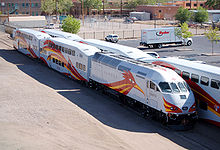 The New Mexico Rail Runner Express is a commuter rail operation train that runs along the Central Rio Grande Valley.
The New Mexico Rail Runner Express is a commuter rail operation train that runs along the Central Rio Grande Valley.
A commuter rail operation, the New Mexico Rail Runner Express, connects the state's capital, its largest city and other communities.[88] The privately-operated state owned railroad began operations in July 2006.[83] The BNSF Railway's entire line from Belen to Raton, New Mexico was sold to the state, partially for the construction of phase II of this operation, which opened in December 2008.[89] Phase II of Rail Runner extended the line northward to Santa Fe from the Sandoval County station, the northernmost station under Phase I service. The service now connects Santa Fe, Sandoval, Bernalillo, and Valencia Counties. The trains connect Albuquerque's population base and central business district to downtown Santa Fe with up to eight roundtrips in a day. The section of the line running south to Belen is served less frequently.[90] Rail Runner operates scheduled service seven days per week.[91]
With the rise of rail transportation many settlements grew or were founded and the territory became a tourist destination. As early as 1878, the ATSF promoted tourism in the region with emphasis on Native American imagery.[92]:64 Named trains often reflected the territory they traveled: Super Chief, the streamlined successor to the Chief;[92] Navajo, an early transcontinental tourist train; and Cavern, a through car operation connecting Clovis and Carlsbad (by the early 1950s as train 23–24)[86]:49–50[93]:51, were some of the named passenger trains of the ATSF that connoted New Mexico.
Passenger train service once connected nine of New Mexico's present ten most populous cities (the exception is Rio Rancho), while today passenger train service connects two: Albuquerque and Santa Fe.[88] With the decline of most intercity rail service in the United States in the late 1960s, New Mexico was left with minimal services. No less than six daily long-distance roundtrip trains supplemented by many branch line and local trains served New Mexico in the early 1960s. Declines in passenger revenue, but not necessarily ridership, prompted many railroads to turn over their passenger services in truncated form to Amtrak, a state owned enterprise. Amtrak, also known as the National Passenger Railroad Corporation, began operating the two extant long-distance routes in May 1971.[86][92][93] Resurrection of passenger rail service from Denver to El Paso, a route once plied in part by the ATSF's El Pasoan[93]:37, has been proposed over the years. As early as the 1980s former Governor Toney Anaya proposed building a high-speed rail line connecting the two cities with New Mexico's major cities.[94] Front Range Commuter Rail is a project to connect Wyoming and New Mexico with high-speed rail.[95]
Amtrak's Southwest Chief passes through daily at stations in Gallup, Albuquerque, Lamy, Las Vegas, and Raton, offering connections to Los Angeles, Chicago and intermediate points.[96] The Southwest Chief is the fastest Amtrak long distance train, being permitted a maximum speed of 90 mph (140 km/h) in various places on the tracks of the BNSF Railway.[97] It also operates on New Mexico Rail Runner Express trackage. The Southwest Chief is the successor to the Super Chief and El Capitan.[93]:115 The streamliner Super Chief, a favorite of early Hollywood stars, was one of the most famous named trains in the United States and one of the most esteemed for its luxury and exoticness—train cars were named for regional Native American tribes and outfitted with the artwork of many local artists—but also for its speed: as few as 39 hours 45 minutes westbound.[92]
The Sunset Limited makes stops three times a week in both directions at Lordsburg, and Deming, serving Los Angeles, New Orleans and intermediate points.[98] The Sunset Limited is the successor to the Southern Pacific Railroad's train of the same name and operates exclusively on Union Pacific trackage in New Mexico.
Aerospace
The Albuquerque International Sunport is the state's primary port of entry for air transportation.
Upham, near Truth or Consequences is the location of the world's first operational and purpose-built commercial spaceport, Spaceport America.[99][100][101] Rocket launches began in April 2007.[101] It is undeveloped and has one tenant, UP Aerospace, launching small payloads.[102] Virgin Galactic, a space tourism company, plans to make this their primary operating base.[100][103]
Law and government
State of New Mexico Elected Officials Governor Susana Martinez (R) Lieutenant Governor John Sanchez (R) Secretary of State Dianna Duran (R) Attorney General Gary King (D) State Auditor Hector Balderas (D) State Treasurer James B. Lewis (D) State Land Commissioner Ray Powell (D) Public Regulation Commission - Jason Marks (D)
- Patrick H. Lyons (R)
- Jerome Block Jr. (D)
- Theresa Becenti-Aguilar (D)
- Ben Hall (R)
The Constitution of 1912, as amended, dictates the form of government in the state.
On March 18, 2009, the Governor signed the law abolishing the death penalty (although the repeal is not retroactive to capital crimes committed before it took effect) in New Mexico after the assembly and senate vote the week before, thus becoming the 15th U.S. state to abolish the penalty.[104]
Governor Susana Martinez and Lieutenant Governor John Sanchez, both Republicans, were elected in 2010. Their terms expire in January 2015. Governors serve a term of four years and may seek re-election for one additional term (limit of two terms). New Mexico has had more governors than any other state in the United States. Juan de Oñate was appointed by the Spanish crown as the first governor of New Mexico in 1598. Since then, New Mexico has had Spanish, Mexican, and American governors. For a list of past governors, see List of New Mexico Governors.
Other constitutional officers, all of whose terms also expire in January 2015, include Secretary of State Dianna Duran,[105] Attorney General Gary King,[106] State Auditor Hector Balderas,[107] State Land Commissioner Ray Powell,[108] and State Treasurer James B. Lewis.[109] King, Balderas, Lewis, and Powell are Democrats. Duran is a Republican.
The New Mexico State Legislature consists of a 70-seat House of Representatives and a 42-seat Senate.
New Mexico's members of the United States Senate are Democrats Jeff Bingaman and Tom Udall. Democrats Martin Heinrich, and Ben R. Luján represent the first and third congressional districts, respectively, and Republican Steve Pearce represents the second congressional district in the United States House of Representatives. See New Mexico congressional map.
Voter Registration and Party Enrollment as of January 31, 2011[update][110] Party Number of Voters Percentage Democratic 571,363 49% Republican 369,730 32% Other 217,630 19% Total 1,158,723 100% Politics
New Mexico is considered a swing state, whose population has favored both Democratic and Republican presidential candidates in the past. The current governor is Susana Martinez (R), who succeeded Bill Richardson (D) on January 1, 2011 after he served two terms as governor from 2003 to 2011. Prior to Richardson, Gary Johnson (R) served as governor from 1995 to 2003. In previous presidential elections, Al Gore carried the state in 2000; George W. Bush won New Mexico's five electoral votes in 2004, and the state's electoral votes were won by Barack Obama in 2008.
Democratic strongholds in the state include the Santa Fe Area, the west and south sides of the Albuquerque Metro Area, Northern and West Central New Mexico, and most of the Native American reservations, particularly the Navajo Nation. Republicans have traditionally had their strongholds in the eastern and southern parts of the state (Little Texas), Rio Rancho, and Albuquerque's Northeast Heights.
Education
Due to the state's various research facilities, New Mexico had the highest concentration of PhD holders of any state in 2000.[111]
Primary and secondary education
The New Mexico Public Education Department oversees the operation of primary and secondary schools.
Colleges and universities
Culture
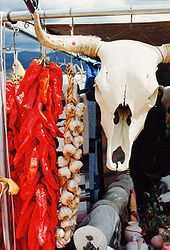 Symbols of the Southwest—a string of chili peppers and a bleached white cow's skull hang in a market near Santa Fe
Symbols of the Southwest—a string of chili peppers and a bleached white cow's skull hang in a market near Santa Fe
With a Native American population of 134,000 in 1990, New Mexico still ranks as an important center of Native American culture. Both the Navajo and Apache share Athabaskan origin. The Apache and some Ute live on federal reservations within the state. With 16 million acres (6,500,000 ha), mostly in neighboring Arizona, the reservation of the Navajo Nation ranks as the largest in the United States. The prehistorically agricultural Pueblo Indians live in pueblos scattered throughout the state.
More than one-third of New Mexicans claim Hispanic origin, many are descendants of colonial settlers. They settled in the northern portion of the state. Most of the Mexican immigrants reside in the southern part of the state.
There are many New Mexicans who also speak a unique dialect of Spanish. New Mexican Spanish has vocabulary often unknown to other Spanish speakers. Because of the historical isolation of New Mexico from other speakers of the Spanish language, the local dialect preserves some late medieval Castilian vocabulary considered archaic elsewhere, adopts numerous Native American words for local features, and contains much Anglicized vocabulary for American concepts and modern inventions.
Albuquerque has the New Mexico Museum of Natural History and Science, the National Hispanic Cultural Center, and the National Museum of Nuclear Science & History, as well as hosts the famed annual Albuquerque International Balloon Fiesta every fall.
Art and literature
A large artistic community thrives in Santa Fe, and has included such people as Bruce Nauman, Richard Tuttle, John Connell and Steina Vasulka. The capital city has museums of Spanish colonial, international folk, Navajo ceremonial, modern Native American, and other modern art. Another museum honors late resident Georgia O'Keeffe. Colonies for artists and writers thrive, and the small city teems with art galleries. In August, the city hosts the annual Santa Fe Indian Market, which is the oldest and largest juried Native American art showcase in the world.
Performing arts include the renowned Santa Fe Opera which presents five operas in repertory each July to August, the Santa Fe Chamber Music Festival held each summer, and the restored Lensic Theater a principal venue for many kinds of performances. The weekend after Labor Day boasts the burning of Zozobra, a 50 ft (15 m) marionette, during Fiestas de Santa Fe.
In the mid-20th century there was a thriving Hispano school of literature and scholarship being produced in both English and Spanish. Among the more notable authors were: Angélico Chávez, Nina Otero-Warren, Fabiola Cabeza de Baca, Aurelio Espinosa, Cleofas Jaramillo, Juan Bautista Rael, and Aurora Lucero-White Lea.
As well, writer D. H. Lawrence lived near Taos in the 1920s at the D. H. Lawrence Ranch where there is a shrine said to contain his ashes.
Silver City, in the southwestern mountains of the state, was originally a mining town, and at least one nearby mine still operates. It is perhaps better known now as the home of and/or exhibition center for large numbers of artists, visual and otherwise.
Sports
Notable professional sports teams based in New Mexico include the professional teams Albuquerque Isotopes, Triple A affiliate of the Los Angeles Dodgers (baseball), New Mexico Thunderbirds, NBA D-League (basketball), New Mexico Mustangs, North American Hockey League (ice hockey), and the New Mexico Renegades, Western States Hockey League (ice hockey). The state universities field teams in many sports; teams include the University of New Mexico Lobos and the New Mexico State Aggies.
Olympic gold medalist Tom Jager, who is an advocate of controversial high-altitude training for swimming, has conducted training camps in Albuquerque (elevation 5,312 ft (1,619.1 m)) and Los Alamos (7,320 ft (2,231 m)).[112]
See also
- Outline of New Mexico
- Index of New Mexico-related articles
- List of National Register of Historic Places in New Mexico
- List of people from New Mexico
- Southern Rocky Mountains
- The New Deal and the arts in New Mexico
- The Center, New Mexico
References
- ^ "Language Use, English Ability, and Linguistic Isolation for the Population 5 Years and Over by State: 2000". United States Census 2000. United States Census Bureau. February 25, 2003. http://www.census.gov/population/www/cen2000/briefs/phc-t20/tables/tab01.pdf. Retrieved March 28, 2010.
- ^ Shin, Hyon B.; Bruno, Rosalind (October 2003). "Language Use and English-Speaking Ability: 2000". Census 2000 Brief. United States Census Bureau. http://www.census.gov/prod/2003pubs/c2kbr-29.pdf. Retrieved March 28, 2010.
- ^ "Wheeler". NGS data sheet. U.S. National Geodetic Survey. http://www.ngs.noaa.gov/cgi-bin/ds_mark.prl?PidBox=GM0779. Retrieved October 24, 2011.
- ^ a b "Elevations and Distances in the United States". United States Geological Survey. 2001. http://egsc.usgs.gov/isb/pubs/booklets/elvadist/elvadist.html. Retrieved October 24, 2011.
- ^ a b Elevation adjusted to North American Vertical Datum of 1988.
- ^ Ogunwole, Stella U. (February 2002). "The Native American Indian and Alaska Native Population: 2000". Census 2000 Brief. United States Census Bureau. http://www.census.gov/prod/2002pubs/c2kbr01-15.pdf. Retrieved August 5, 2007.
- ^ New Mexico State Flag – About the New Mexico Flag, its adoption and history from NETSTATE.COM
- ^ a b c d "CLIMATE OF NEW MEXICO". New Mexico State University. http://weather.nmsu.edu/News/climate-in-NM.htm. Retrieved March 20, 2010.
- ^ "Rivers of the World". USGS. http://ga.water.usgs.gov/edu/riversofworld.html. Retrieved May 22, 2010.
- ^ "Find a Forest by State". USDA Forest Service. http://www.fs.fed.us/recreation/map/state_list.shtml#NewMexico. Retrieved March 20, 2010.
- ^ "New Mexico". National Park Service. http://www.nps.gov/state/nm. Retrieved July 17, 2008.[dead link]
- ^ "All-Time Climate Extremes for NM". National Climatic Data Center. http://www.ncdc.noaa.gov/extremes/scec/getextreme.php?forwhat=st&elem=ALL&state=NM. Retrieved March 18, 2011.
- ^ Merriam Bailey, Florence (1928). Birds of New Mexico. The University of Michigan.
- ^ Hogan, C. Michael (2008). "Wild turkey: Meleagris gallopavo". GlobalTwitcher.com. http://www.globaltwitcher.com/artspec_information.asp?thingid=2199. Retrieved April 2, 2010.
- ^ New Mexico; New Mexico Compilation Commission (1966). New Mexico statutes, 1953, annotated. 2. Indianapolis: A. Smith Co.. p. 68. OCLC 28494004. http://books.google.com/books?id=TdpGAQAAIAAJ. Retrieved July 31, 2011.
- ^ a b Murphy, Dan (2000). New Mexico, the distant land: an illustrated history. photo research by John O. Baxter (2000 ed.). Sun Valley, CA: American Historical Press. ISBN 9781892724090.
- ^ a b c d e f g h i j k l Simmons, Marc (1988). New Mexico: An Interpretive History (New ed.). Albuquerque: University of New Mexico Press. ISBN 0826311105.
- ^ Stewart, George (2008) [1945]. Names on the Land: A Historical Account of Place-Naming in the United States. New York: NYRB Classics. pp. 23–24. ISBN 9781590172735. "There was Francisco de Ibarra, a great seeker after gold mines. In 1563 he went far to the north...when he returned south, Ibarra boasted that he had discovered a New Mexico. Doubtless, like others, he stretched the tale, and certainly the land of which he told was well south of the one now so called. Yet men remembered the name Nuevo México, though not at first as that of the region which Coronado had once conquered."
- ^ "Cuarto Centenario: 400 Years of New Mexico Culture and History". New Mexico Department of Cultural Affairs. 1999. http://www.newmexicoculture.org/CuartoCentenario/index.html. Retrieved October 12, 2008.
- ^ a b Simmons, Mark (1991). The Last Conquistador: Juan De Oñate and the Settling of the Far Southwest. Norman: University of Oklahoma Press. ISBN 0806123680.
- ^ Resistance and Accommodation in New Mexico. Source: C. W. Hackett, ed., Historical Documents relating to New Mexico, Nueva Vizcaya, and Approaches Thereto, to 1773, vol. III [Washington: Carnegie Institution of Washington, 1937] pp. 327–35.
- ^ "The Founding of Albuquerque – The Albuquerque Museum". City of Albuquerque. http://www.cabq.gov/museum/history/foundingabq.html. Retrieved October 12, 2008.
- ^ "Texas Annexation Questions and Answers". Texas State Library and Archives Commission. http://www.tsl.state.tx.us/exhibits/annexation/aftermath/question10.html. Retrieved October 12, 2008.
- ^ "Boundaries of the Louisiana Purchase as Recognized Today". Louisiana: European Explorations and the Louisiana Purchase. Library of Congress. December 2001. http://memory.loc.gov/ammem/collections/maps/lapurchase/essay1e_lg.html. Retrieved December 6, 2008.
- ^ New Mexico (state). Britannica Online Encyclopedia.
- ^ a b "Table 16. Population: 1790 to 1990" (PDF). Population and Housing Unit Counts. 1990 Census of Population and Housing. CPH-2-1. U.S. Department of Commerce, Bureau of the Census. pp. 26–27. ISBN 9994641255. http://2010.census.gov/2010census/data/apportionment-dens-text.php. Retrieved July 3, 2008.
- ^ a b c "Annual Estimates of the Resident Population for the United States, Regions, States, and Puerto Rico: April 1, 2000 to July 1, 2009". United States Census Bureau. http://www.census.gov/popest/states/tables/NST-EST2009-01.csv. Retrieved April 11, 2010.
- ^ Resident Population Data – 2010 Census
- ^ Reynis, Lee A.; Marshall J. Vest (2005). "The Southwest Heartland: The Good, the Bad & the Ugly" (PDF). University of New Mexico, Bureau of Business and Economic Research. p. 12. http://www.unm.edu/~bber/pubs/WRSA.pdf. Retrieved October 12, 2008.
- ^ a b c U.S. Census Bureau (December 15, 2008). "Cumulative Estimates of the Components of Population Change for the United States, Regions and States: April 1, 2000 to July 1, 2008 (NST-EST2008-04)" (CSV). http://www.census.gov/popest/states/tables/NST-EST2008-04.csv. Retrieved January 16, 2009.
- ^ "Population and Population Centers by State: 2000". United States Census Bureau. http://www.census.gov/geo/www/cenpop/statecenters.txt. Retrieved December 6, 2008.
- ^ a b c d e "New Mexico QuickFacts from the US Census Bureau". United States Census Bureau. http://quickfacts.census.gov/qfd/states/35000.html. Retrieved March 28, 2010.
- ^ "Table 4: Annual Estimates of the Resident Population for Incorporated Places in New Mexico, Listed Alphabetically: April 1, 2000 to July 1, 2010 (SUB-EST2008-04-35)" (CSV). US Census Bureau, Population Division. 2-10-11. http://www.bizjournals.com/albuquerque/news/2010/12/22/US-Census-population-New-Mexico-cities.html. Retrieved 2-10-11.
- ^ "Table 1: Annual Estimates of the Resident Population for Counties of New Mexico: April 1, 2000 to July 1, 2008 (CO-EST2008-01-35)" (CSV). US Census Bureau, Population Division. March 19, 2009. http://www.census.gov/popest/counties/tables/CO-EST2008-01-35.csv. Retrieved July 10, 2009.
- ^ "2010 Census Data". U.S. Census Bureau. http://2010.census.gov/2010census/data/. Retrieved March 29, 2011.
- ^ "Census Bureau Releases State and County Data Depicting Nation's Population Ahead of 2010 Census" (Press release). US Census Bureau. May 14, 2009. http://www.census.gov/Press-Release/www/releases/archives/population/013734.html. Retrieved July 17, 2009. "New Mexico had the highest percentage of Hispanics at 45 percent."
- ^ Demographic Profile of Hispanics in New Mexico, 2007. Pew Hispanic Center.
- ^ "Alaska QuickFacts from the US Census Bureau". US Census Bureau. http://quickfacts.census.gov/qfd/states/02000.html. Retrieved April 10, 2010.
- ^ US Census 2006–2008 American Community Survey 3-Year Estimates
- ^ Brittingham, Angela; G. Patricia de la Cruz (June 2004). "Table 3. Largest Ancestries for the United States, Regions, States, and for Puerto Rico: 2000" (PDF). Ancestry: 2000; Census 2000 Brief. US Census Bureau. http://www.census.gov/prod/2004pubs/c2kbr-35.pdf. Retrieved November 8, 2008.
- ^ "MLA Language Map Data Center: Most spoken languages in New Mexico". Mla.org. July 17, 2007. http://www.mla.org/map_data_results&state_id=35&mode=state_tops. Retrieved July 31, 2010.
- ^ "The Spanish language in New Mexico and southern Colorado". Archive.org. http://www.archive.org/stream/spanishlanguagei00espirich/spanishlanguagei00espirich_djvu.txt. Retrieved July 31, 2010.
- ^ Crawford, John (1992). Language loyalties: a source book on the official English controversy. Chicago: University of Chicago Press. p. 62.
- ^ a b Cobarrubias, Juan; Fishman, Joshua A (1983). Progress in Language Planning: International Perspectives.. Walter de Gruyter. p. 195.
- ^ a b c Constitution of the State of New Mexico. Adopted January 21, 1911.
- ^ Perea, Juan F.. Los Olvidados: On the Making of Invisible People.. New York University Law Review, 70(4), 965-990.
- ^ a b Joseph, John Earl (2006). Language and Politics.. Edinburgh University Press. p. 63.
- ^ Roberts, Calvin A. (2006). Our New Mexico: A Twentieth Century History.. Albuquerque: University of New Mexico Press. p. 23.
- ^ "State Symbols". New Mexico Blue Book 2007–2008. New Mexico Secretary of State. http://www.sos.state.nm.us/BlueBook2008/StateSymbols.pdf. Retrieved January 3, 2009.
- ^ Felcia Fonseca (31 July 2008). "New Mexico first state to adopt Navajo textbook". Seattle Times. http://seattletimes.nwsource.com/html/nationworld/2008083264_apnavajotextbook.html?syndication=rss. Retrieved 29 October 2011.
- ^ http://www.ldsnewsroom.lds.org%7CLDS Newsroom
- ^ Collected by the Association of Statisticians of American Religious Bodies (ASARB) and distributed by the Association of Religion Data Archives. State Membership Report: New Mexico. Religious Congregations and Membership in the United States, 2000.. http://www.thearda.com/mapsReports/reports/state/35_2000.asp. Retrieved September 19, 2008.
- ^ Pew Forum on Religion & Public Life. (February 2008) (PDF). U.S. Religious Landscape Survey: Religious Affiliation: Diverse and Dynamic. Pew Research Center. http://religions.pewforum.org/maps. Retrieved June 25, 2008.
- ^ "ARCHDIOSF.ORG". http://www.archdiosf.org/. Retrieved April 11, 2010.
- ^ "GDP by State". Greyhill Advisors. http://greyhill.com/gdp-by-state. Retrieved September 9, 2011.
- ^ "Per Capita Personal Income by State". University of New Mexico, Bureau of Business and Economic Research. April 4, 2008. http://www.unm.edu/~bber/econ/us-pci.htm. Retrieved October 13, 2008.
- ^ "Persons Below Poverty by New Mexico County". University of New Mexico, Bureau of Business and Economic Research. January 18, 2008. http://www.unm.edu/~bber/demo/SAIPEallagepov05.htm. Retrieved October 13, 2008.
- ^ "Travel Economic Impact Model" (PDF). New Mexico Tourism Department. http://www.newmexico.org/department/research/docs/Economic_Impact_FY2006.pdf. Retrieved October 2, 2008.
- ^ "Local Area Unemployment Statistics". BLS. http://www.bls.gov/web/laus/laumstch.htm. Retrieved September 23, 2011.
- ^ "EIA State Energy Profiles: New Mexico". US Department of Energy, Energy Information Administration. October 9, 2008. http://tonto.eia.doe.gov/state/state_energy_profiles.cfm?sid=NM. Retrieved October 9, 2008.
- ^ "Oil & Gas Program". New Mexico Institute of Technology, New Mexico Bureau of Geology and Mineral Resources. http://geoinfo.nmt.edu/resources/petroleum/. Retrieved October 9, 2008.
- ^ "Federal Spending Received Per Dollar of Taxes Paid by State, 2005". Tax Foundation. October 9, 2007. http://www.taxfoundation.org/research/show/266.html. Retrieved September 21, 2008.
- ^ Dr. Chris Erickson; Erin Ward (May 2005). "Economic Impact of the Closure of Cannon Air Force Base". New Mexico Business Outlook. New Mexico State University. Archived from the original on September 2, 2006. http://web.archive.org/web/20060902233558/http://bbrs.nmsu.edu/nmbizoutlook/showarticle.php?articleID=50106. Retrieved October 13, 2008.
- ^ "Business Assistance: Incentives". State of New Mexico Economic Development Department. http://www.edd.state.nm.us/businessAssistance/incentives/index.html. Retrieved June 2, 2008.
- ^ Domrzalski, Dennis (2003-09-19). 28 New Mexico towns tap into $45M in incentives. OCLC 30948175. http://www.bizjournals.com/albuquerque/stories/2003/09/22/story2.html. Retrieved June 2, 2008.
- ^ "Governor Signs Film Production Tax Incentives". New Mexico Economic Development Department. March 4, 2002. Archived from the original on November 14, 2006. http://web.archive.org/web/20061114192754/http://www.nmpartnership.com/press-releases/article.php?id=1022&title=Governor+Signs+Film+Production+Tax+Incentives. Retrieved September 12, 2007.
- ^ "New Mexico's Film Incentives". New Mexico Film Office. http://www.nmfilm.com/filming/incentives/. Retrieved June 2, 2008.
- ^ Hay, Kiera (2007-12-10). State's Incentives Keep Film Industry Growing. Albuquerque Journal. OCLC 9392114. http://www.abqjournal.com/AED/268427business12-10-07.htm. Retrieved June 2, 2008.
- ^ "Personal Income Tax Rates" (PDF). State of New Mexico Taxation and Revenue Department. August 25, 2008. p. 3. http://www.tax.state.nm.us/forms/year08/pitrates_2005_2008.pdf. Retrieved September 4, 2008.
- ^ "Governor Richardson Announces New Laws to Take Effect; New State laws go into effect June 15, 2007" (PDF) (Press release). Office of the Governor, State of New Mexico. June 14, 2008. http://www.governor.state.nm.us/press/2007/june/061407_04.pdf. Retrieved September 5, 2008. "HB 436 Working Families Tax Credit...eliminates taxes on active duty military salaries."
- ^ "Gross Receipts Taxes FAQ" (PDF). State of New Mexico, Taxation and Revenue Department. August 6, 2006. http://www.tax.state.nm.us/oos/GrossReceiptsTaxFAQ.pdf. Retrieved October 9, 2008.
- ^ "Gross Receipts Tax Rate Schedule, Effective July 1, 2008 through December 31, 2008" (PDF). State of New Mexico, Taxation and Revenue Department. June 5, 2008. http://www.tax.state.nm.us/pubs/GrossReceiptsRates/grt_rates_july_2008.pdf. Retrieved October 9, 2008.
- ^ "Property Tax FAQ" (PDF). State of New Mexico, Taxation and Revenue Department. August 7, 2007. http://www.tax.state.nm.us/oos/PropertyTaxFAQ.pdf. Retrieved October 9, 2008.
- ^ Chaco Canyon
- ^ Suina, Kim. "Indigenous trade". Digital History Project—Book of Migrations. New Mexico Office of the State Historian. http://www.newmexicohistory.org/story2.php?catid=727. Retrieved March 31, 2009.
- ^ Santa Fe Trail Association
- ^ Santa Fe National Historic Trail (U.S. National Park Service)
- ^ Los Angeles Times, New Mexico turns a corner on drunk driving, July 7, 2009, by Kate Linthicum, http://articles.latimes.com/2009/jul/07/nation/na-new-mexico-dwi7
- ^ U.S. Department of Transportation Bureau of Transportation Statistics, Table 1-2: New Mexico Public Road Length, Miles by Ownership 2000 [1]
- ^ U.S. Department of Transportation Bureau of Transportation Statistics, Table 1-1: New Mexico Public Road Length, by Functional System [2]
- ^ U.S. Department of Transportation Bureau of Transportation Statistics, Table 2-1: Highway Traffic Fatalities and Fatality Rates: 2000
- ^ U.S. Department of Transportation Bureau of Transportation Statistics, Table 1-5: Highway Bridge Condition: 2001 [3]
- ^ a b Holmes, Sue Major (January 14, 2009). "Mass. firm sues state over Railrunner name". Boston Globe. http://www.boston.com/news/local/massachusetts/articles/2009/01/14/mass_firm_sues_state_over_railrunner_name/. Retrieved February 2, 2009.[dead link]
- ^ "ABQ RIDE – City of Albuquerque". City of Albuquerque. http://www.cabq.gov/transit/index.html. Retrieved April 12, 2010.
- ^ a b U.S. Department of Transportation Bureau of Transportation Statistics,Table 1-9: Freight Railroads in New Mexico and the United States: 2000 [4]
- ^ a b c d e f g h i Myrick, David F. (1970). New Mexico's Railroads—An Historical Survey. Golden, Colorado: Colorado Railroad Museum. ISBN 0826311857. Library of Congress Catalog Card No. 70-116915.
- ^ a b c "New Mexico and its Railroads". La Crónica de Nuevo México/New Mexico Office of the State Historian: Digital History Project—The Book of Mapping. Historical Society of New Mexico. August 1984. http://www.newmexicohistory.org/story2.php?catid=731. Retrieved March 31, 2009.
- ^ a b Stations – New Mexico Rail Runner Express
- ^ Grimm, Julie Ann (December 17, 2008). "Delays, struck cow mark Rail Runner's first day, but riders optimistic". The Santa Fe New Mexican. http://www.santafenewmexican.com/Local%20News/Delays-mark-first-morning-of-commuter-train-service. Retrieved February 2, 2009.
- ^ "New Mexico Rail Runner Express weekday schedule" (PDF). http://www.nmrailrunner.com/PDF/Weekday%20Schedule%20SF%2012-08.pdf. Retrieved July 31, 2010.
- ^ "Rail Runner schedule page". Nmrailrunner.com. April 12, 2010. http://www.nmrailrunner.com/schedule.asp. Retrieved July 31, 2010.
- ^ a b c d Richards, C Fenton Jr (2001). Santa Fe – The Chief Way. Second Printing, 2005. Robert Strein & John Vaughn. New Mexico Magazine. ISBN 0-937206-71-7.
- ^ a b c d Dorin, Patrick C. (2004). Santa Fe Passenger Trains in the Streamlined Era. design and layout by Megan Johnson. USA: TLC Publishing, Inc.. ISBN 1-883089-99-9.
- ^ Herron, Gary (December 22, 2008). "Media and politicians enjoy inaugural ride, public opening met with delays". The Observer (UK). http://www.observer-online.com/articles/2008/12/21/news/doc494d4df4b3d01455138411.txt. Retrieved February 2, 2009.
- ^ Proctor, Cathy (May 15, 2005). "Idea floated for Front Range rail line". http://www.bizjournals.com/denver/stories/2005/05/16/story2.html.
- ^ "Southwest Chief passenger timetable". Amtrak. October 2008. http://www.amtrak.com/timetable/oct08/P03.pdf. Retrieved February 2, 2009.
- ^ Blaszak, Michael W. (2009). "Speed, Signals, and Safety". Fast Trains. Classic Trains Special Edition No. 7 (Waukesha, Wisconsin: Kalmbach Publishing Co.): 47. ISBN 978-0-89024-763-1.
- ^ "Sunset Limited passenger timetable". Amtrak. January 2009. http://www.amtrak.com/timetable/jan09/P01.pdf. Retrieved February 2, 2009.
- ^ Ohtake, Miyoko (August 25, 2007). "Virgin Galactic Preps for Liftoff at World's First Commercial Spaceport". Wired Magazine (15:10). http://www.wired.com/science/space/magazine/15-10/st_spaceport. Retrieved January 24, 2009.
- ^ a b Robinson-Avila (December 31, 2008). "NM Spaceport, Virgin Galactic sign 20-year lease". New Mexico Business Weekly. http://www.bizjournals.com/albuquerque/stories/2008/12/29/daily19.html. Retrieved January 24, 2009.
- ^ a b "First Commercial Spaceport Gets Green Light". Discovery Channel. December 19, 2008. http://dsc.discovery.com/news/2008/12/19/spaceport-commercial.html. Retrieved January 24, 2009.
- ^ UP Aerospace does launches ‘quickly and cheaply’, DenverBiz Journal, October 2008 [5]
- ^ "News Release 03.04.2008 / Spaceport Sweden and Virgin Galactic". http://www.virgingalactic.com/htmlsite/news.php. Retrieved June 26, 2008.
- ^ Le Nouveau-Mexique abolit la peine de mort [archive] in Le Monde of March 19, 2009
- ^ "NM Secretary of State's Office official web site". Sos.state.nm.us. http://www.sos.state.nm.us. Retrieved July 31, 2010.
- ^ "NM Attorney General's Office official web site". Ago.state.nm.us. http://www.ago.state.nm.us. Retrieved July 31, 2010.
- ^ "NM State Auditor's Office official web site". Saonm.org. http://www.saonm.org. Retrieved July 31, 2010.
- ^ "NM State Lands official web site". Nmstatelands.org. http://www.nmstatelands.org. Retrieved July 31, 2010.
- ^ "NM State Treasurer's Office official web site". Stonm.org. http://www.stonm.org. Retrieved July 31, 2010.
- ^ "Voter Registration Statistics" (PDF). New Mexico Secretary of State Elections Bureau. http://www.sos.state.nm.us/pdf/COUNTY013111.pdf. Retrieved January 31, 2011.
- ^ "Venture Capitals". Wired. http://www.wired.com/wired/archive/8.07/silicon_pr.html. Retrieved July 31, 2010.
- ^ "High Hopes: Altitude Training for Swimmers", by Michael Scott, SwimmingworldMagazine.com magazine archives [6] (10-15-08)
Further reading
- Beck, Warren. Historical Atlas of New Mexico 1969.
- Chavez, Thomas E. An Illustrated History of New Mexico, 267 pages, University of New Mexico Press 2002, ISBN 0-8263-3051-7
- Bullis, Don. New Mexico: A Biographical Dictionary, 1540–1980, 2 vol, (Los Ranchos de Albuquerque: Rio Grande, 2008) 393 pp. isbn 978-1-890689-17-9
- Gonzales-Berry, Erlinda, David R. Maciel, eds. The Contested Homeland: A Chicano History of New Mexico, 314 pages – University of New Mexico Press 2000, ISBN 0-8263-2199-2
- Gutiérrez; Ramón A. When Jesus Came, the Corn Mothers Went Away: Marriage, Sexuality, and Power in New Mexico, 1500–1846 (1991)
- Hain; Paul L., F. Chris Garcia, Gilbert K. St. Clair; New Mexico Government 3rd ed. (1994)
- Horgan, Paul, Great River, The Rio Grande in North American History, 1038 pages, Wesleyan University Press 1991, 4th Reprint, ISBN 0585380147, Pulitzer Prize 1955
- Larson, Robert W. New Mexico's Quest for Statehood, 1846–1912 (1968)
- Nieto-Phillips, John M. The Language of Blood: The Making of Spanish-American Identity in New Mexico, 1880s–1930s, University of New Mexico Press 2004, ISBN 08236324231
- Simmons, Marc. New Mexico: An Interpretive History, 221 pages, University of New Mexico Press 1988, ISBN 0-8263-1110-5, good introduction
- Szasz; Ferenc M., and Richard W. Etulain, eds. Religion in Modern New Mexico (1997)
- Trujillo, Michael L. Land of Disenchantment: Latina/o Identities and Transformations in Northern New Mexico (2010) 265 pages; An experimental ethnography that contrasts life in the Espanola Valley with the state's commercial image as the "land of enchantment."
- Weber; David J. Foreigners in Their Native Land: Historical Roots of the Mexican Americans (1973), primary sources to 1912
Primary sources
- Ellis, Richard, ed. New Mexico Past and Present: A Historical Reader. 1971. primary sources
- Tony Hillerman, The Great Taos Bank Robbery and other Indian Country Affairs, University of New Mexico Press, Albuquerque, 1973, trade paperback, 147 pages, (ISBN 0-8263-0530-X), fiction
External links
- State Government
- New Mexico Government
- New Mexico's Blue Book On-Line – State of New Mexico, Secretary of State (print almanac of statistics and information)
- Bureau of Elections New Mexico Major and Minor Political Parties
- New Mexico State Databases – Annotated list of searchable databases produced by New Mexico state agencies and compiled by the Government Documents Roundtable of the American Library Association.
- Bureau of Business and Economic Research (BBER) at University of New Mexico (statistical information about the New Mexico economy)
- U.S. Government
- New Mexico State Guide, from the Library of Congress
- Energy Profile for New Mexico– Economic, environmental, and energy data
- New Mexico – Science In Your Backyard – United States Geological Society
- "American Southwest" – Discover Our Shared Heritage travel itinerary – National Park Service
- New Mexico dataset – United States Census Bureau
- New Mexico state facts – Economic Research Service – United States Department of Agriculture
- Directory
- New Mexico at the Open Directory Project
- Tourism

 Utah
Utah Colorado
Colorado Kansas
Kansas
 Arizona
Arizona
 Oklahoma
Oklahoma
 Texas
Texas New Mexico: Outline • Index
New Mexico: Outline • Index 

 Sonora
Sonora Chihuahua
Chihuahua
 Mexico
Mexico State of New Mexico
State of New MexicoSanta Fe (capital) Topics Delegations · Geography · Government · History · Landmarks · Military · Natural history · New Mexicans · Settlements · Transportation · Tribes · Visitor attractions
Society Culture · Demographics · Economy · Education · Politics
Regions Cities Alamogordo · Albuquerque · Artesia · Carlsbad · Clovis · Corrales · Deming · Española · Farmington · Gallup · Grants · Hobbs · Las Cruces · Las Vegas · Los Alamos · Los Lunas · Lovington · Portales · Raton · Rio Rancho · Roswell · Ruidoso · Santa Fe · Silver City · Socorro · Sunland Park · Taos · Tucumcari
Counties Bernalillo · Catron · Chaves · Cibola · Colfax · Curry · De Baca · Doña Ana · Eddy · Grant · Guadalupe · Harding · Hidalgo · Lea · Lincoln · Los Alamos · Luna · McKinley · Mora · Otero · Quay · Rio Arriba · Roosevelt · Sandoval · San Juan · San Miguel · Santa Fe · Sierra · Socorro · Taos · Torrance · Union · Valencia
Preceded by
OklahomaList of U.S. states by date of statehood
Admitted on January 6, 1912 (47th)Succeeded by
ArizonaCoordinates: 34°N 106°W / 34°N 106°W
United States (Outline) History Pre-Columbian era · Colonial era (Thirteen Colonies · Colonial American military history) · American Revolution (War) · Federalist Era · War of 1812 · Territorial acquisitions · Territorial evolution · Mexican–American War · Civil War · Reconstruction era · Indian Wars · Gilded Age · African-American Civil Rights Movement (1896–1954) · Spanish–American War · Imperialism · World War I · Roaring Twenties · Great Depression · World War II (Home front) · Cold War · Korean War · Space Race · African-American Civil Rights Movement (1955–1968) · Feminist Movement · Vietnam War · Post-Cold War (1991–present) · War on Terror (War in Afghanistan · Iraq War) · Timeline of modern American conservatismTopicsDemographic · Discoveries · Economic (Debt Ceiling) · Inventions (before 1890 · 1890–1945 · 1946–1991 · after 1991) · Military · Postal · Technological and industrialFederal
governmentLegislature - Congress
Senate
· Vice President
· President pro tem
House of Representatives
· Speaker
Judiciary - Supreme Court
Federal courts
Courts of appeal
District courtsExecutive - President
Executive Office
Cabinet / Executive departments
Civil service
Independent agencies
Law enforcement
Public policy
Intelligence
Central Intelligence Agency
Defense Intelligence Agency
National Security Agency
Federal Bureau of InvestigationPolitics Divisions · Elections (Electoral College) · Foreign policy · Foreign relations · Ideologies · Local governments · Parties (Democratic Party · Republican Party · Third parties) · Political status of Puerto Rico · Red states and blue states · Scandals · State governments · Uncle SamGeography Cities, towns, and villages · Counties · Extreme points · Islands · Mountains (Peaks · Appalachian · Rocky) · National Park System · Regions (Great Plains · Mid-Atlantic · Midwestern · New England · Northwestern · Southern · Southwestern · Pacific · Western) · Rivers (Colorado · Columbia · Mississippi · Missouri · Ohio · Rio Grande) · States · Territory · Water supply and sanitationEconomy Agriculture · Banking · Communications · Companies · Dollar · Energy · Federal Budget · Federal Reserve System · Financial position · Insurance · Mining · Public debt · Taxation · Tourism · Trade · Transportation · Wall StreetSociety TopicsCrime · Demographics · Education · Family structure · Health care · Health insurance · Incarceration · Languages (American English · Spanish · French) · Media · People · Public holidays · Religion · SportsArchitecture · Art · Cinema · Cuisine · Dance · Fashion · Flag · Folklore · Literature · Music · Philosophy · Radio · Television · TheaterIssues Book ·
Book ·  Category ·
Category ·  Portal ·
Portal ·  WikiProjectCategories:
WikiProjectCategories:- New Mexico
- States of the United States
- States and territories established in 1912
- Former Spanish colonies
Wikimedia Foundation. 2010.

